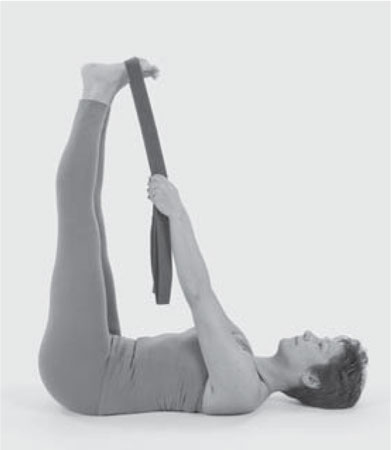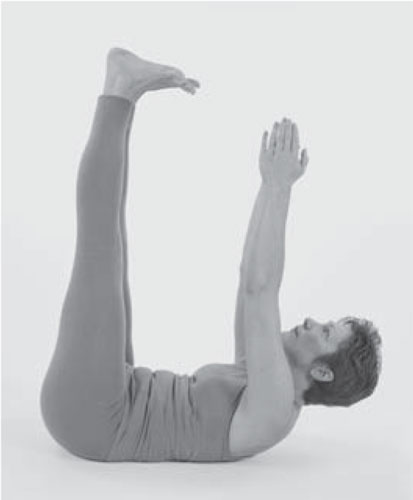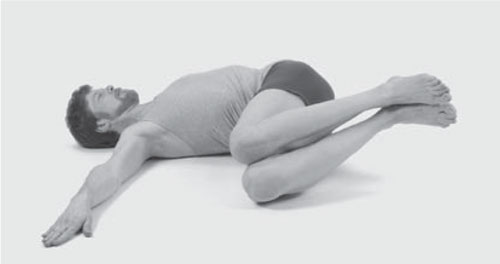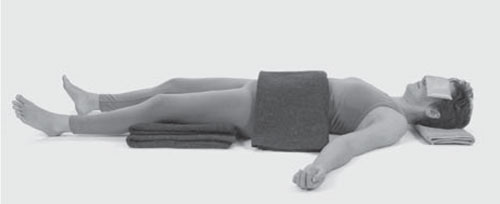Yoga for a Healthy Lower Back (36 page)
Read Yoga for a Healthy Lower Back Online
Authors: Liz Owen

Step 2: Full Upward-Legs Pose
Leaving your legs raised, put your belt aside, then reach your arms all the way up over your head to the floor. If you feel any amount of discomfort in your back, place your hands under your hips instead; if that doesn't relieve your discomfort, remain in Supported Upward-Legs Pose. Stay in the full pose for about ten seconds. Breathe fully and deeply, stretching your legs up with each inhalation and knitting your abdominal wall together with each exhalation.
To come out, bend your knees back into your chest and hug them for a few moments, then move your legs gently from side to side to massage your lower back. Rest your legs flat on the floor and relax for a few breaths.
Place your hands on your abdomen and feel the warmth and energy you have created in your core. Be particularly mindful of your psoas (hip flexor) muscle, which can feel overworked or tight after this pose. For most practitioners, lying with legs flat on the floor and breathing down into the hips is enough to release the tension after practicing this pose. But if your psoas muscles are tight to begin with, proceed through these poses with mindful caution.

FIG. 5.4
Upward-Legs Curl-Up
Strengthen | Urdhva Prasarita Padasana Variation 1
If your lower back is comfortable in Full Upward-Legs Pose, you're ready to progress into Upward-Legs Curl-Up. Otherwise, see below for modifications that will help you practice the pose with greater comfort.
Start in Upward-Legs Pose with your arms over your head. As you exhale, lift your arms up toward the ceiling (not trying to touch your toes) and curl your shoulders and head up off the floor (
fig. 5.5
). Hold yourself up for two seconds, and as you inhale, bring your shoulders, head, and arms back down to the floor. Repeat the pose, curling up again with your next exhalation.
Upward-Legs Curl-Up is a brisk poseâmove in and out of it fairly quickly, following your natural inhalations and exhalations. Practice three repetitions at first and then come out; make sure your lower back is comfortable. Increase the repetitions as you feel stronger, cycling through the pose up to ten times.
If your back needs more support in this pose, keep one foot grounded on the floor. Practice four or five repetitions to one side, then change legs and repeat to the opposite side. For even more support, keep both feet on the ground. If your neck feels strained when you lift your shoulders and head off the floor, support your head with your hands.
To come out of the pose, hug your knees into your chest for a few moments and then rest with your legs flat on the floor, again taking care to note the condition and comfort of your lower back.

FIG. 5.5
Active Bent-Knee Twist
Stretch and Strengthen | Jathara Parivartanasana Variation 2
After a pose such as Upward-Legs Curl-Up, a simple lying twist feels delicious, because the abdominals get a good stretch and any tension in them is released. You'll “taste” that in a minute, but before you do, you'll practice a version that strengthens and tones your internal and external oblique muscles. Trust me, this will make your “just dessert” even sweeter!
Lie on the floor and draw your knees to your chest. Stretch your arms out to the sides even with your shoulders. Turn your palms down. Feel your upper back and shoulders fully grounded on the floor. Take a deep inhalation and feel your chest broadening, and as you exhale, slowly take your legs down to the right, keeping your knees and feet together as you go. Bring your right thigh and knee down to the floor, but keep your right shin and foot off the floor (
fig. 5.6
). Your left shoulder should stay grounded. If your knee can't reach the floor or if your lower back is in discomfort, support your right knee on a block.
Draw your outer left hip away from your waist and draw your lower back muscles in toward your abdomen. You'll feel some muscular effort along the sides of your trunkâthese are the external and internal oblique muscles we've discussed. Also, see if you can feel your lower back lengthening and releasing. Turn your head to look at your left hand, and stay in the pose for a few breaths. With an inhalation, bring your legs back up to center and repeat to the opposite side as you exhale. Repeat again to each side.

FIG. 5.6
Relaxing Bent-Knee Twist
Rest | Jathara Parivartanasana Variation 3
If Bent-Knee Twist is comfortable in your lower back, you can practice it now as a resting pose . . . the delicious “dessert” I promised you! Begin as above, but now take your whole right leg down to the floor or onto a block, whichever your body prefers. Stay for a few breaths and enjoy the feeling of length and release in your abdomen and lower back. You can deepen the twist by pressing your right hand down on your left thigh and turning your torso more to the left.
To come out of this resting version, draw your knees up to your armpit before you bring them back to the center. Take a deep inhalation as you lift your legs up, and with an exhalation repeat the pose to the opposite side. If your lower back feels tight, you can choose to practice
Reclining Bolster Twist
instead. Or, release your lower back and soften your abdomen for a few moments in
Happy Baby Pose
.
Deep Relaxation: Illuminate Your Core
Rest | Shavasana Variation 4
As we prepare to deeply relax at the end of our practice, I'd like to introduce a yogic idea that will help you rest into all we've done for your abdominal core so far.
One goal of yoga practice is to balance the three qualities of nature that exist in everything in the universe, including your own body. These qualities, or
gunas
in Sanskrit, are:
â¢Â Â
Tamas:
inertia, rest, and darkness
â¢Â Â
Rajas:
movement, activity, and passion
â¢Â Â
Sattva:
equanimity and illumination
I'm sure you've experienced all three of these qualities in yourself at various times. Sometimes it's clear which guna is predominant, such as when you're having a really lazy day (tamas), or when you've got an extraordinary amount of energy (rajas). At other times you've probably felt that your energy level is a mix of rest, action, and the interplay between them.
When the gunas are balanced, the quality of sattva becomes predominant and the practitioner moves into a state of physical and mental equilibrium. In such a balanced state, he isn't affected by the push and pull of tamas and rajas, and according to the Yoga Sutras of Patanjali, he “comes to experience his own soul with crystal clarity.”
16
The gunas have an important relationship to the abdominal area. Tamas resides in the lower abdomen and hips, and rajas lives between the navel and heart. Abdominal practices wake up tamas, that dark, resting inertia. As Kundalini energy uncoils and the energy of the lower body rises up into the chest, tamas unites with rajas, the quality of passionate, active movement. Together, the two gunas travel up through the spine; when they reach the top of your head at the crown (Sahasrara) chakra, they turn into sattva, illumination.
As you relax, I'll take you through a visualization of these qualitiesâhow they awaken, how they move through your hips and abdomen and up through your body to your head, and how they turn into the light that illuminates the path to your true nature.
Lie down comfortably on your mat or on a blanket. Place a folded blanket under your thighs with the top edge of the blanket at your upper thighs. You should feel your lower back lengthening. If your sacrum is in discomfort, support it with a folded towel. Place another folded blanket across your abdomen as a reminder for it to relax. Support your head so your neck is comfortable, and place an eye pillow over your eyes as a reminder for your eyes to quiet down and look within.

FIG. 5.7
Inhale down into your belly, feeling it expand gently upward while you visualize the skin, layers of myofascia, and layers of muscles lengthening and opening. Visualize all those layers relaxing down into the earth as you exhale. Take a few breaths and let the energy of your abdomen become quiet and settled.
Visualize the inner fire and heat you created as you practiced the exercises in this chapter as a luminous elliptical light in your abdomen. Now that your inner fire is lit (and is nice and hot), let it break through the dullness and darkness (the tamas guna) that tends to settle into your hips. Visualize that inner fire awakening the serpentine Kundalini energy that lies in wait at the base of your spine. Visualize Kundalini energy as a beautiful, luminous light winding up through the central channel of the spine from your sacral chakra to your lower back, carrying rajas, the quality of movement that we used in our practice, into your upper body and head. When the light reaches your head, let it become pure illumination, sattva, making your mind clear and pure. Let the light linger in your head for a few moments and visualize its radiance.
Now visualize the light slowly moving back down your body, all the way to the base of your spine. Feel yourself fully grounded to the earth. Feel the energy of your body perfectly balanced between rest and action and between darkness and light. Feel your mind balanced, and visualize your light illuminating your path of awareness.
Grow and Progress
Reawaken Your Fire: Abdominal Lock
Uddiyana Bandha
You practiced Root Lock, or Mula Bandha, in
chapter 2
, lifting your perineal floor and lower abdomen in and up toward your spine. Now you'll find the strong energetic lock called Uddiyana Bandha, or Abdominal Lock. In Sanskrit,
uddiyana
means “flying up” or “soaring”âand that's just the way it feels, as if your abdomen and everything in it were soaring up into your chest. Uddiyana Bandha tones the abdomen, increases inner fire, and
helps to flush toxins out of your inner organs.
17
Energetically speaking, Abdominal Lock cleans out the residue of what is burned up by your inner fire.
Uddiyana Bandha can be practiced either standing up or sitting down. I'll teach it to you in a seated position so you can feel your hips grounded to the earth and the strong upward lift in your abdomen. You'll see that it makes sense to practice Abdominal Lock only on an empty stomach. It's contraindicated for abdominal pain or inflammation, fever, during the menstrual cycle, and during late pregnancy.
